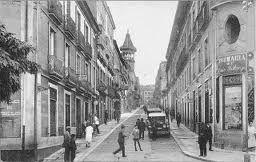Here is a sample of your compositions about your favourite television programmes:
My Favourite Film
by Andrew 2nd ESO A
8 Mile
I think “8 Mile” is the best film in the world. It’s an American film about Eminem and his life and his dreams: he sings and wants to be a famous rapper.
I watched this film with my brother because he loves Eminem too.
The most important characters are Eminem (“Rabbit”), his mum, Lindsay, and his sister, Emily. They lose his father in a car accident.
Eminem is older than Emily and Emily is the youngest. Eminem works in a factory because he can’t pay for his studies. He hasn’t got much money but he wants to win the Rappers Rhythm in a gym. Finally he wins the 1,000 million dollars.
I like this film because it’s Eminem’s life but in a film. The actors are fantastic and there’s often good music. In the film, my favourite songs are “I’m not afraid” and “Never enough”.
This is a great film, the best I’ve ever seen.
My Favourite TV Programme
by Sara Álvarez 2nd ESO A
I think “El Barco” is the best programme on TV. It’s a Spanish soap opera about some people who live in a boat. I usually watch it with my friends because we all like it.
The most important characters are Ulises, Ainhoa, her dad the Captain and the doctor Wilson. In the series, the world is finished and the boat is safe.
I like “El Barco” because it’s very interesting. The actors are fantastic and there’s always good music in the programme too.
My Favourite TV Programme
by María Feijoo 2nd ESO B
I think “El Intermedio” is the best programme on TV. It’s a Spanish comedy programme about some humorists and reporters. They talk about the funniest news in the world. I always watch it with my family because we all like it.
The most important characters are ·”El Gran Wyoming” and his team: Beatriz, Thais, Dani, Usun and Gonzo. They are usually joking. Beatriz and Wyoming tell the news every day. Dani is a humorist. Usun, Gonzo and Thais are the reporters.
I like “El Intermedio” because it’s interesting and very funny. Wyoming and Dani are fantastic and they often tell jokes and they sometimes sing.
My Favourite TV Programme
by Alejandro Rey 2nd ESO B
I think “One Piece” is the best programme on TV. It’s a Japanese cartoon about pirates, their band and their enemies. I usually watch it with my sister because we both like it.
The most important characters are Luffy and his band, Zorro, Snaji, Chopper, Usup, Robin and Nami. Zorro is stronger than Sanji. They argue a lot. The strongest pirate is Luffy and Usup is the weakest.
The band is traveling along the Grand Line Ocen and they are fighting with strong enemies. They always win the battles.
I like “One Piece” because it’s exciting and there are entertaining moments and a lot of action. The characters are fantastic.

























